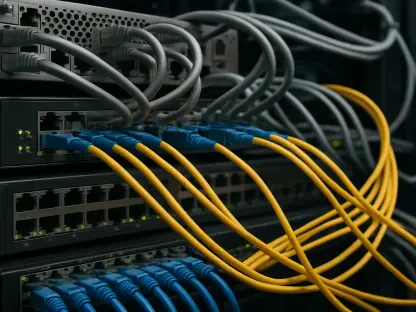The telecom industry has undergone significant transformations with the advent of 5G and the Internet of Things (IoT), leading to profound impacts on communication services. Companies like Deutsche Telekom AG, Telefonica S.A., and Shenandoah Telecommunications Company are positioned to capitalize on these technological advancements. The industry’s outlook remains positive, driven by increasing demand for scalable infrastructure, enhanced by fiber densification and accelerated global 5G deployments. However, these advancements come with their own set of challenges, notably high capital expenditures and fluctuating raw material prices.
Rising Demand for Scalable Infrastructure
Impact of 5G Deployment
As companies strive to meet the demands of consumers and businesses alike, the deployment of 5G technology is becoming a cornerstone for telecommunications infrastructure. The fifth generation of mobile network technology offers higher speeds, lower latency, and increased capacity, revolutionizing how data is transmitted and received. This transition is critical as the global appetite for data continues to grow exponentially, requiring more robust and scalable solutions.
The push for 5G is not merely about faster mobile internet. It encompasses a broader scope, including the development of smart cities, autonomous vehicles, and advanced healthcare systems. The higher bandwidth and reliability of 5G networks enable more devices to connect simultaneously without compromising performance. This is crucial for applications in IoT, where devices need to communicate in real-time to function effectively. The deployment of 5G also supports the transition to cloud computing, allowing for more efficient data processing and storage.
Proliferation of IoT
The Internet of Things (IoT) is another significant factor driving the need for advanced telecom infrastructure. IoT involves the interconnection of everyday objects, ranging from household appliances to industrial machinery, through the internet. This connectivity allows for real-time monitoring, data collection, and automation, leading to increased efficiency and convenience. As IoT adoption grows, telecom companies must invest in networks capable of handling the added demand.
IoT devices require reliable connections and sufficient bandwidth to function correctly. The proliferation of these devices means that networks must be upgraded to prevent congestion and ensure seamless operations. This has led to significant investments in fiber optics and other high-capacity infrastructure. Telecom companies are also exploring software-defined networks that offer flexibility and scalability, essential for managing the diverse needs of IoT applications. These investments promise long-term benefits but also pose financial challenges in the short term.
Short-Term Challenges in Infrastructure Investment
High Capital Expenditures and Raw Material Fluctuations
The substantial investments required for upgrading telecom infrastructure present a significant challenge. Companies are spending billions on developing 5G networks, expanding broadband access, and enhancing fiber optics. These capital expenditures, while necessary, strain financial resources and impact short-term profitability. Additionally, the cost of raw materials such as copper and silicon can fluctuate, adding another layer of financial uncertainty.
In this complex landscape, companies must balance the need for innovation with fiscal responsibility. Strategies include prioritizing projects with the highest return on investment and seeking partnerships to share costs. Furthermore, regulatory support and incentives can help alleviate some of the financial burdens, making large-scale infrastructure projects more manageable. Despite these challenges, the long-term benefits of these investments are clear, promising improved services and new revenue streams.
Geopolitical and Macroeconomic Factors
Geopolitical instability and a challenging macroeconomic environment further complicate the telecom industry’s landscape. Trade tensions, regulatory changes, and fluctuations in currency exchange rates can all impact the cost and feasibility of infrastructure projects. Additionally, economic slowdowns can affect consumer spending and business investments, leading to delayed or scaled-back telecom initiatives.
Companies must navigate these uncertainties by adopting flexible and adaptive strategies. This includes diversifying supply chains to mitigate risks and investing in emerging markets with high growth potential. Moreover, robust financial planning and risk management practices are essential to weather economic fluctuations and maintain momentum in infrastructure development. While these factors present short-term challenges, they also underscore the importance of adaptive and forward-thinking strategies in telecom.
Innovations and Market Diversification
Transition to Modern Technology Powerhouses
In response to these challenges, telecom companies are transforming from traditional copper-based operations to modern technology powerhouses. This transformation aims to generate higher revenue per user and leverage advanced technologies to enhance service offerings. Companies are focusing on low-latency, high-bandwidth applications crucial for industries such as healthcare, finance, and entertainment, where reliable and fast data transmission is paramount.
The adoption of software-defined networking (SDN) and network function virtualization (NFV) is central to this transformation. These technologies enable telecom providers to manage networks more efficiently, reducing costs and improving scalability. By transitioning to more flexible and responsive network architectures, companies can better meet the evolving demands of their customers. This shift also opens up opportunities in adjacent markets, offering new revenue streams and avenues for growth.
Exploring New Revenue Opportunities
Telecom companies are increasingly exploring opportunities beyond traditional communication services. By venturing into sectors such as consumer goods, agriculture, and digital health services, they aim to diversify revenue streams and capitalize on emerging trends. For instance, in agriculture, IoT solutions can optimize farming practices through real-time data, enhancing productivity and sustainability. In healthcare, telemedicine and remote monitoring are becoming integral, necessitating reliable and expansive network services.
This diversification is not merely about entering new markets but about leveraging core competencies to offer innovative solutions. Telecom companies can provide connectivity and data analytics, critical components in today’s digital economy. By focusing on these high-growth sectors, companies can mitigate risks associated with traditional markets and ensure sustainable growth. The insights gained from these ventures can also inform and enhance core telecom offerings, creating a synergistic effect.
Preparing for a Transformative Future
The telecom industry has experienced immense changes with the rise of 5G and the Internet of Things (IoT), significantly impacting communication services. Companies such as Deutsche Telekom AG, Telefonica S.A., and Shenandoah Telecommunications Company are well-positioned to take advantage of these technological innovations. The industry’s future looks promising, driven by a growing demand for more scalable infrastructure, an aspect greatly enhanced by fiber densification and the rapid deployment of 5G networks worldwide. However, these advancements bring inherent challenges. Notably, the significant capital expenditures required and the fluctuations in raw material prices present concerns for the industry. These factors must be carefully managed to ensure sustainable growth and continued advancements in communication capabilities in this rapidly evolving field. Despite these hurdles, the telecom sector’s evolution underscores its critical role in shaping the future of connectivity and communication on a global scale.









